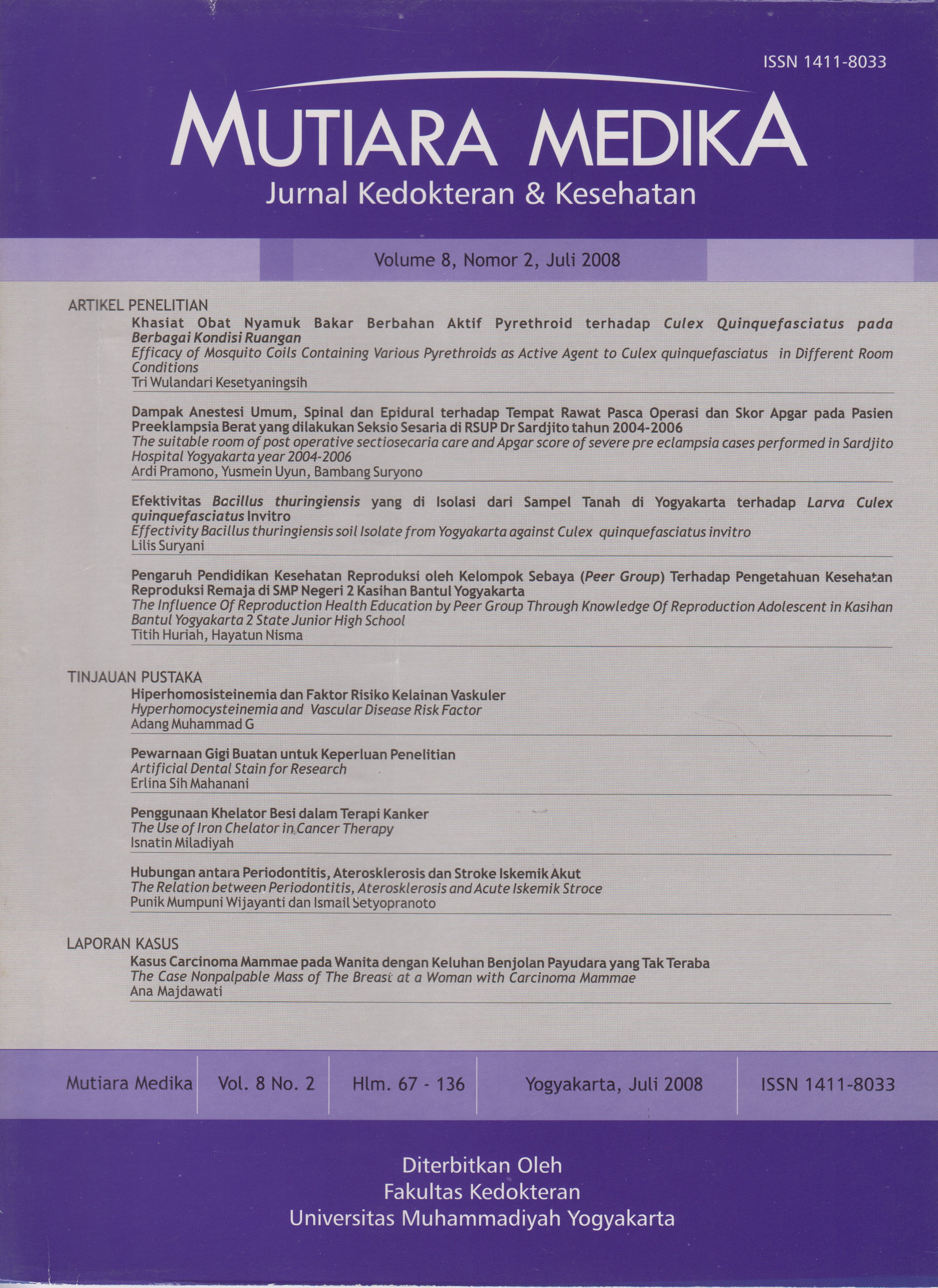Efektifitas Bacillus Thuringiensis yang Diisolasi dari Sampel Tanah di Yogyakarta Terhadap Larva Culex Quinquefasciatus Invitro
DOI:
https://doi.org/10.18196/mmjkk.v8i2.1479Keywords:
Bacillus thuringiensis, Culex quinquefasciatus larvae, pathogenecity activity, daya patogenesitas LarvaAbstract
Filariasis disease is a public health problem, especially in rural areas. One kinds of mosquitoes that transmited it is Culex quinquefasciatus. Since 1972 chemical insecticides has been usedfor vector control in Indonesia. However, in 1987 it was reported that there are many areas has been resistant against chemical insecticides. Bacillus thuringiensis is a gram positif bacteria, rod, aerobic and spore shape. There are many strain of this bacteria produces a toxic protein to insect. This research try to reveal the effectivity of Bacillus thuringiensis soil isolate from Yogyakarta, Bantul, Sleman, Kulonprogo and Wonosari area, as larvacide against Culex quenquefasciatus. This study is an experimental laboratory, as subject research is Bacillus thuringiensis which tested its pathogenecity against Culex quinquefasciatus larvae . The result of this study shows that Bacillus thuringiensis soil isolate from Wonosari has a high effectivity as larvacide against Culex quinquefasciatus with pathogenecity activity 100%, Bacillus thuringiensis soil isolate from Sleman has a low effectivity with pathogenecity activity 38,7%. It is conduced that Bacillus thuringiensis isolate Wonosari has a high effectivity as larvacide against Culex quinquefasciatus larvae.
Penyakit filariasis merupakan masalah kesehatan masyarakat, terutama di daerah rural. Salah satu j enis nyamuk yang menularkan penyakit ini adalah Culex quinquefasciatus. Sej ak tahun 1972 insektisida kimiawi telah banyak digunakan untuk pengendalian vektor di Indonesia. Namun pada tahun 1987 dilaporkan di beberapa daerah telah terjadi resistensi nyamuk vektor terhadap beberapa jenis insektisida kimiawi. Bacillus thuringiensis adalah bakteri gram positif yang berbentuk batang, aerobik dan membentuk spora. Banyak strain dari bakteri ini yang menghasilkan protein yang beracun bagi serangga. Penelitian ini mencoba mengungkapkan efektifitas Bacillus thuringiensis yang diisolasi dari sampel tanah di daerah Istimewa Yogyakarta, meliputi wilayah Bantul, Sleman, Kota Yogyakarta, Wonosari dan Kulonprogo sebagai larvasida Culex quinquefasciatus. Penelitian ini merupakan penelitian eksperimental laboratorium, dengan subyek penelitian berupa kuman ito7/ws thuringiensis yang diuji patogenesitasnya terhadap larva Culex quinquefasciatus, sebagai pembanding digunakan bakteri standar Bacillus thuringiensis H-14. Hasil penelitian ini menunjukkan bahwa Bacillus thuringiensis isolat Wonosari memiliki efektifitas yang tinggi sebagai larvasida terhadap nyamuk Culex quinquefasciatus dengan daya patogenesitas 100%. Bacillus thuringiensis isolat Sleman memiliki efektifitas yang rendah sebagai larvasida terhadap nyamuk Culex quinquefasciatus dengan daya patogenesitas 38,7%. Kesimpulan dari penelitian ini adalah Bacillus thuringiensis isolat Wonosari memiliki efektifitas tinggi sebagai larvasida terhadap nyamuk Culex quinquefasciatus.
References
WHO. 1999, Enviromental health criteria: Bacillus thuringiensis, B.thuringiensis/ EHC217,.
Kristian Bayu K dan Alvonsus. 2007, Bacillus thuringiensis. htto:// www.indobioaen.or.id/Droduk/ bacillus.php.
Lindquist,J., 2000, Isolation of Bacilus, Departement of Bacteriology, University of Wisconsin, Madison.
Chilcott CN, Wigley PJ. Technical note: an improved method for differential staining of Bacillus thuringiensis crystals. Letters in Appl Microbiol 1988;7: 67-70.
Jenssen, G.B., Larsen, P., Jacobsen, B et al., 2002. Bacillus thuringiensis infecal samples from greenhouse workers after exposure to B. thuringiensis based pesticides. Journal Virology Applied and Environmental Microbiology. Vol 68. No. 10. p.4900-4905.
Li,J., Caroll, Ellar., 1991. The Microbial World : Bacillus thuringiensis, Nature 353. p.815-821.
Downloads
Published
Issue
Section
License
Copyright
Authors retain copyright and grant Mutiara Medika: Jurnal Kedokteran dan Kesehatan (MMJKK) the right of first publication with the work simultaneously licensed under an Attribution 4.0 International (CC BY 4.0) that allows others to remix, adapt and build upon the work with an acknowledgment of the work's authorship and of the initial publication in Mutiara Medika: Jurnal Kedokteran dan Kesehatan (MMJKK).
Authors are permitted to copy and redistribute the journal's published version of the work (e.g., post it to an institutional repository or publish it in a book), with an acknowledgment of its initial publication in Mutiara Medika: Jurnal Kedokteran dan Kesehatan (MMJKK).
License
Articles published in the Mutiara Medika: Jurnal Kedokteran dan Kesehatan (MMJKK) are licensed under an Attribution 4.0 International (CC BY 4.0) license. You are free to:
- Share — copy and redistribute the material in any medium or format.
- Adapt — remix, transform, and build upon the material for any purpose, even commercially.
This license is acceptable for Free Cultural Works. The licensor cannot revoke these freedoms as long as you follow the license terms. Under the following terms:
Attribution — You must give appropriate credit, provide a link to the license, and indicate if changes were made. You may do so in any reasonable manner, but not in any way that suggests the licensor endorses you or your use.
- No additional restrictions — You may not apply legal terms or technological measures that legally restrict others from doing anything the license permits.






